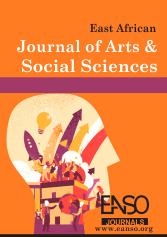Emotional Deprivation and Alcohol Abuse as Predictors of Dating Violence Among Young Adults in Lagos State
Abstract
Dating violence is a significant public health concern, particularly among youths, where emotional and behavioural factors may contribute to the escalation of such behaviours. This cross-sectional study investigates the influence of emotional regulation and alcohol abuse as well as sex on dating violence among young adults in Lagos State, using a sample of 486 participants. It was hypothesized that young adults who are male will be more likely to engage in dating violence than females and emotional deprivation and alcohol abuse will have an independent and joint influence on dating violence among young adults. The results revealed a significant influence of sex on dating violence (t = 3.197; df (485); p <.05). Furthermore, male young adults were more likely to engage in dating violence than their counterparts. Additionally, alcohol abuse was found to have both independent and joint predictive effects with emotional deprivation on dating violence (R² = .310, F (2,484) = 108.49, p < .05). The study suggested that parents and caregivers should consciously pay attention to both the physical and emotional needs of children. The study also advocates for comprehensive programs by governmental and non-governmental organizations to prevent and minimize alcohol abuse among young adults in Lagos state and for those experiencing dating violence, the study encourages seeking help and speaking out, emphasizing that victims are not to blame and that support is available. Additionally, perpetrators of dating violence are encouraged to seek help to improve their behaviour
Downloads
References
Archer, J. (2000). Sex differences in aggression between heterosexual partners: A meta-analytic review. Psychological Bulletin, 126(5), 651–680.
Arqimandriti, M., Lena, O., Uka A., & Kapllanaj, M. (2018). Intimate Partner Violence in Adolescence Albania. AWEN.
Atmaca, S., & Gençöz, T. (2016). Exploring revictimization process among Turkish women: The role of early maladaptive schemas on the link between child abuse and partner violence. Child abuse & neglect, 52, 85–93. https://doi.org/10.1016/j.chiabu.2016.01.004
Bandura, A. (1977). Self-efficacy: toward a unifying theory of behavioral change. Psychological Review, 84(2), 191
Bonomi, A. E., Anderson, M. L., Nemeth, J., Bartle-Haring, S., Buettner, C., & Schipper, D. (2012). Dating violence victimization across the teen years: Abuse frequency, number of abusive partners, and age at first occurrence. BMC Public Health, 12(1). https://doi.org/10.1186/1471- 2458-12-637
Cafferky, B. M., Mendez, M., Anderson, J. R., & Stith, S. M. (2018). Substance use and intimate partner violence: A meta-analytic review. Psychology of Violence, 8(1), 110–131. https://doi.org/10.1037/vio0000074
Carlos, D. M., Campeiz, A. B., Silva, J. L., Fernandes, M. I. D., Leitão, M. N. C., Silva, M. A. I. and Ferriani, M. G. C., (2017). School based interventions for teen dating violence prevention: integrative literature review. Review P per Antigo De Revısão, 218: 133-144
Catalano, S. M. (2006). Intimate partner violence in the United States. Washington, DC: US Department of Justice, Office of Justice Programs, Bureau of Justice Statistics.
Centers for Disease Control and Prevention. (2006). Dating Abuse fact. Morbidity and mortality weekly;55(19):532-535.
Foran, H. M., & O’Leary, K. D. (2008). Alcohol and intimate partner violence: A meta-analytic review. Clinical Psychology Review, 28(7), 1222–1234.
Francalanci, C., Chiassai, S., Ferrara, G., Ferretti, F., & Mattei, R. (2011). Scale for the measurement of attitudes towards alcohol. Alcohol and Alcoholism, 46(2), 133–137. https://doi.org/10.1093/alcalc/agq094
Gillette, H. (2022). How childhood emotional neglect impacts adult relationships and how to heal
Kelly, J. B., & Johnson, M. P. (2008). Differentiation Among Types of Intimate Partner Violence: Research Update And Implications For Interventions. Family Court Review, 46(3), 476– 499. https://doi.org/10.1111/j.1744-1617.2008.00215.x
Klencakova, L., Pentaraki, M., & McManus, C. (2021). The Impact of Intimate Partner Violence on Young Women’s Educational Well-Being: A Systematic Review of Literature. Trauma, Violence, & Abuse, 24(2), 1172– 1187. https://doi.org/10.1177/15248380211052244
Lipsky S., Caetano R., Field C. A., Larkin G. L. (2005). Is there a relationship between victim and partner alcohol use during an intimate partner violence event? Findings from an urban emergency department study of abused women. Journal of Studies on Alcohol, 66, 407– 412. https://doi.org/10.15288/jsa.2005.66.407
Low, S., Tiberio S. S., Shortt J. W., Capaldi D. M., Eddy J. M. (2017). Associations of couples’ intimate partner violence in young adulthood and substance use: A dyadic approach. Psychology of Violence, 7, 120–127. https://doi.org/10.1037/vio0000038
Paglia, D. M. (2021). Emotional Deprivation Schema: What it is and How to Deal with it
Pilkington, P. D., Noonan, C., May, T., Younan, R., & Holt, R. A. (2021). Early maladaptive schemas and intimate partner violence victimization and perpetration: A systematic review and meta-analysis. Clinical psychology & psychotherapy, 28(5), 1030–1042.
Rodríguez-Díaz, F. J., Herrero, J., Rodríguez-Franco, L., Molleda, C. B., Paíno-Quesada, S., & Pérez, B. (2017). Validation of Dating Violence Questionnaire-R (DVQ-R). International Journal of Clinical and Health Psychology, 17(1), 77–84.
Steele C., Josephs R. (1988). Drinking your troubles away: II. An attention-allocation model of alcohol’s effect on psychological stress. Journal of Abnormal Psychology, 97, 196–205.
Thompson, M. P., & Kingree, J. B. (2006). The Roles of Victim and Perpetrator Alcohol Use in Intimate Partner Violence Outcomes. Journal of Interpersonal Violence, 21(2), 163–177. https://doi.org/10.1177/0886260505282283
Victor, M., & Adams, R. D. (1953). The effect of alcohol on the nervous system. Research Publications - Association for Research in Nervous and Mental Disease, 32, 526–573. https://pubmed.ncbi.nlm.nih.gov/13134661/
Wekerle, C., & Wolfe, D. A. (1998). The role of child maltreatment and attachment style in adolescent relationship violence. Development and Psychopathology, 10(3), 571–586. https://doi.org/10.1017/s0954579498001758
World Health Organization. (2013). Global and regional estimates of violence against women: prevalence and health effects of intimate partner violence and non-partner sexual violence.
Yildirim-Hamurcu, S., & Terzioglu, F. (2023). Attitudes toward dating violence among Turkish university students: The relationships with self- esteem level and gender roles. Archives of psychiatric nursing, 45, 131– 136. https://doi.org/10.1016/j.apnu.2023.06.010
Young, J. E., Klosko, J. S. & Weishaar, M. E. (2003). Schema therapy: A practitioner’s guide. New York: Guilford Press.
Copyright (c) 2025 Quadri Ayomide Lawal, Paul Oluwaseyi Animashaun

This work is licensed under a Creative Commons Attribution 4.0 International License.




























